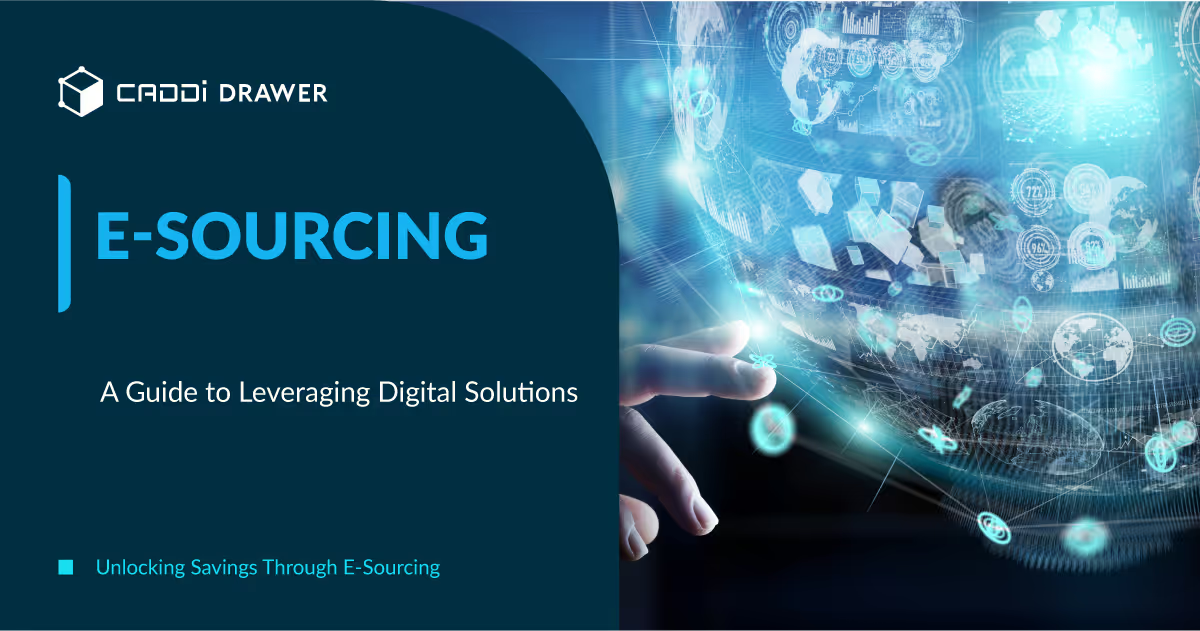Procurement 101: Green Procurement – How it works and why it’s important

Table of Contents

What is Green Procurement?
Green procurement, also known as sustainable procurement, is a strategic approach to sourcing goods and services that minimizes environmental impact while maximizing social and economic benefits. It’s not just about buying eco-friendly products; it’s a holistic process that considers the entire lifecycle of a product or service, from raw materials to disposal.
Imagine a manufacturing company as a chef in a kitchen. Just as a chef carefully selects the freshest, highest-quality ingredients to create a delicious meal, a company practicing green procurement meticulously chooses suppliers and materials that align with its sustainability goals. This involves:
- Evaluating suppliers’ environmental and social practices
- Choosing products with minimal packaging and low toxicity
- Prioritizing renewable and recycled materials
- Considering the energy efficiency of equipment and processes
Without green procurement, companies risk contributing to environmental degradation, supporting unethical labor practices, and wasting resources. It’s like a chef using inferior, unsustainable ingredients – the final product suffers, and the long-term consequences can be severe.
Green procurement is not to be confused with greenwashing, which is when a company makes misleading or false claims about the environmental benefits of its products or practices. Authentic green procurement requires transparency, accountability, and a genuine commitment to sustainability.
In essence, green procurement is a powerful tool for driving positive change in the business world. By leveraging their purchasing power, companies can create demand for sustainable products and services, encourage innovation, and set new industry standards. It’s a win-win-win: good for the planet, good for people, and good for business.
Challenges in Implementing Green Procurement
While green procurement is a noble pursuit, it’s not without its obstacles. Just as a chef may encounter difficulties in sourcing sustainable ingredients, companies face several challenges when implementing green procurement practices.
1. Higher Costs: One of the most significant barriers is the perceived higher cost of environmentally friendly products and services. Sustainable materials and technologies often come with a premium price tag, which can be a tough pill to swallow for businesses focused on short-term profitability. However, it’s essential to consider the long-term benefits and potential cost savings of green procurement, such as reduced energy consumption and waste disposal costs.
2. Limited Availability: Finding suppliers that meet sustainability criteria can be like searching for a needle in a haystack. The market for green products and services is still developing, and options may be limited, especially for specialized industries. This scarcity can lead to longer lead times, reduced competition, and a lack of bargaining power for buyers.
3. Lack of Standardization: The absence of universally accepted standards for green products and practices makes it challenging to compare and verify suppliers’ environmental claims. Is a supplier truly “green,” or are they just greenwashing? Without clear benchmarks, companies may struggle to make informed decisions and justify their choices to stakeholders.
4. Resistance to Change: Implementing green procurement often requires a significant shift in organizational culture and processes. Employees may be resistant to change, especially if they perceive sustainability as a burden or a threat to their job security. Overcoming this resistance requires strong leadership, clear communication, and a willingness to invest in training and support.
5. Complexity and Time Constraints: Conducting thorough supplier assessments, researching sustainable alternatives, and monitoring compliance can be time-consuming and complex. Procurement teams may feel overwhelmed by the additional workload, especially if they are already stretched thin. Balancing sustainability with other priorities, such as cost and quality, requires careful planning and resource allocation.
While these challenges may seem daunting, they are not insurmountable. With commitment, creativity, and collaboration, companies can overcome these barriers and reap the benefits of green procurement. It’s a journey, not a destination – but one that is well worth embarking upon.
Solutions to the Challenges of Implementing Green Procurement
Just as a chef finds creative ways to source sustainable ingredients, companies can overcome the challenges of green procurement with innovative solutions and strategic approaches.
1. Life-Cycle Costing: One way to address the perceived higher costs of green products is to adopt a life-cycle costing approach. This means looking beyond the initial purchase price and considering the total cost of ownership, including energy consumption, maintenance, and disposal costs. By taking a long-term view, companies may find that green alternatives are actually more cost-effective in the long run.
2. Supplier Engagement and Collaboration: To overcome limited availability and lack of standardization, companies can actively engage with suppliers and collaborate to develop sustainable solutions. By sharing knowledge, setting clear expectations, and providing incentives, buyers can encourage suppliers to adopt greener practices and innovate new products.
3. Training and Education: Addressing resistance to change requires investing in training and education programs to help employees understand the importance and benefits of green procurement. By providing clear guidelines, best practices, and success stories, companies can build a culture of sustainability and empower employees to make environmentally conscious decisions.
4. Prioritization and Phased Implementation: To manage complexity and time constraints, companies can prioritize their green procurement efforts based on factors such as environmental impact, feasibility, and strategic importance. By breaking down the implementation process into manageable phases, procurement teams can gradually build their capacity and expertise over time.
Recent Trends and Future Outlook for Green Procurement
In recent years, green procurement has moved from a niche concern to a mainstream imperative. More and more companies are realizing the value of sustainable sourcing, not just for the environment, but for their bottom line and brand reputation.
There are several remarkable examples of green procurement in the manufacturing sector. One such case is that of GM, a multinational automotive manufacturing company.
In 2017, GM announced its commitment to sourcing sustainable natural rubber for its tires. The company partnered with suppliers, governments, and environmental NGOs to develop a set of sustainable natural rubber procurement practices. These practices aim to promote responsible land use, protect human rights, and enhance the livelihoods of smallholder farmers.
In 2022, John Deere received the Outstanding Program Leadership Award at EcoVadis’ Sustainable Procurement Leadership Awards. John Deere was honored for the efforts of the Supply Chain Sustainability team, demonstrating a strong commitment to integrating sustainability into their supply chains. This commitment aligns with John Deere’s Smart Industrial strategy and new business and sustainability goals, emphasizing the critical role of suppliers in providing sustainable solutions and technologies.
One notable trend is the increasing use of digital tools and platforms to streamline green procurement processes. Just as a chef relies on technology to manage their inventory and recipes, procurement teams are leveraging software solutions to track supplier performance, monitor compliance, and analyze data. For example, the Dutch government has developed a web-based tool called “DuboCalc” to calculate the environmental impact of infrastructure projects and guide sustainable procurement decisions.
Looking ahead, the future of green procurement is likely to be shaped by a combination of regulatory pressures, consumer demands, and technological advancements. As governments around the world set more ambitious sustainability targets, companies will face greater scrutiny and higher expectations. At the same time, the rise of circular economy models and the growing awareness of social and ethical issues in supply chains will drive a more holistic approach to sustainable sourcing.
Conclusion
Green procurement is more than just a trend – it’s a transformative force that is reshaping the way businesses operate and interact with the world around them. By embracing sustainable sourcing practices, companies can create a positive impact on the environment, society, and their own bottom line. It’s a journey that requires vision, commitment, and a willingness to learn and adapt.
As we’ve seen, the path to green procurement is not without its challenges. But by leveraging innovative solutions, collaborating with suppliers, and investing in education and technology, companies can overcome these hurdles and unlock the full potential of sustainable sourcing.
So, whether you’re a seasoned procurement professional or just starting to explore the world of sustainable sourcing, remember this: every journey begins with a single step. By taking action today, no matter how small, you can be part of the solution – and help build a more sustainable, resilient, and prosperous future for all.
What is Green Procurement?
Green procurement, also known as sustainable procurement, is a strategic approach to sourcing goods and services that minimizes environmental impact while maximizing social and economic benefits. It’s not just about buying eco-friendly products; it’s a holistic process that considers the entire lifecycle of a product or service, from raw materials to disposal.
Imagine a manufacturing company as a chef in a kitchen. Just as a chef carefully selects the freshest, highest-quality ingredients to create a delicious meal, a company practicing green procurement meticulously chooses suppliers and materials that align with its sustainability goals. This involves:
- Evaluating suppliers’ environmental and social practices
- Choosing products with minimal packaging and low toxicity
- Prioritizing renewable and recycled materials
- Considering the energy efficiency of equipment and processes
Without green procurement, companies risk contributing to environmental degradation, supporting unethical labor practices, and wasting resources. It’s like a chef using inferior, unsustainable ingredients – the final product suffers, and the long-term consequences can be severe.
Green procurement is not to be confused with greenwashing, which is when a company makes misleading or false claims about the environmental benefits of its products or practices. Authentic green procurement requires transparency, accountability, and a genuine commitment to sustainability.
In essence, green procurement is a powerful tool for driving positive change in the business world. By leveraging their purchasing power, companies can create demand for sustainable products and services, encourage innovation, and set new industry standards. It’s a win-win-win: good for the planet, good for people, and good for business.
Challenges in Implementing Green Procurement
While green procurement is a noble pursuit, it’s not without its obstacles. Just as a chef may encounter difficulties in sourcing sustainable ingredients, companies face several challenges when implementing green procurement practices.
1. Higher Costs: One of the most significant barriers is the perceived higher cost of environmentally friendly products and services. Sustainable materials and technologies often come with a premium price tag, which can be a tough pill to swallow for businesses focused on short-term profitability. However, it’s essential to consider the long-term benefits and potential cost savings of green procurement, such as reduced energy consumption and waste disposal costs.
2. Limited Availability: Finding suppliers that meet sustainability criteria can be like searching for a needle in a haystack. The market for green products and services is still developing, and options may be limited, especially for specialized industries. This scarcity can lead to longer lead times, reduced competition, and a lack of bargaining power for buyers.
3. Lack of Standardization: The absence of universally accepted standards for green products and practices makes it challenging to compare and verify suppliers’ environmental claims. Is a supplier truly “green,” or are they just greenwashing? Without clear benchmarks, companies may struggle to make informed decisions and justify their choices to stakeholders.
4. Resistance to Change: Implementing green procurement often requires a significant shift in organizational culture and processes. Employees may be resistant to change, especially if they perceive sustainability as a burden or a threat to their job security. Overcoming this resistance requires strong leadership, clear communication, and a willingness to invest in training and support.
5. Complexity and Time Constraints: Conducting thorough supplier assessments, researching sustainable alternatives, and monitoring compliance can be time-consuming and complex. Procurement teams may feel overwhelmed by the additional workload, especially if they are already stretched thin. Balancing sustainability with other priorities, such as cost and quality, requires careful planning and resource allocation.
While these challenges may seem daunting, they are not insurmountable. With commitment, creativity, and collaboration, companies can overcome these barriers and reap the benefits of green procurement. It’s a journey, not a destination – but one that is well worth embarking upon.
Solutions to the Challenges of Implementing Green Procurement
Just as a chef finds creative ways to source sustainable ingredients, companies can overcome the challenges of green procurement with innovative solutions and strategic approaches.
1. Life-Cycle Costing: One way to address the perceived higher costs of green products is to adopt a life-cycle costing approach. This means looking beyond the initial purchase price and considering the total cost of ownership, including energy consumption, maintenance, and disposal costs. By taking a long-term view, companies may find that green alternatives are actually more cost-effective in the long run.
2. Supplier Engagement and Collaboration: To overcome limited availability and lack of standardization, companies can actively engage with suppliers and collaborate to develop sustainable solutions. By sharing knowledge, setting clear expectations, and providing incentives, buyers can encourage suppliers to adopt greener practices and innovate new products.
3. Training and Education: Addressing resistance to change requires investing in training and education programs to help employees understand the importance and benefits of green procurement. By providing clear guidelines, best practices, and success stories, companies can build a culture of sustainability and empower employees to make environmentally conscious decisions.
4. Prioritization and Phased Implementation: To manage complexity and time constraints, companies can prioritize their green procurement efforts based on factors such as environmental impact, feasibility, and strategic importance. By breaking down the implementation process into manageable phases, procurement teams can gradually build their capacity and expertise over time.
Recent Trends and Future Outlook for Green Procurement
In recent years, green procurement has moved from a niche concern to a mainstream imperative. More and more companies are realizing the value of sustainable sourcing, not just for the environment, but for their bottom line and brand reputation.
There are several remarkable examples of green procurement in the manufacturing sector. One such case is that of GM, a multinational automotive manufacturing company.
In 2017, GM announced its commitment to sourcing sustainable natural rubber for its tires. The company partnered with suppliers, governments, and environmental NGOs to develop a set of sustainable natural rubber procurement practices. These practices aim to promote responsible land use, protect human rights, and enhance the livelihoods of smallholder farmers.
In 2022, John Deere received the Outstanding Program Leadership Award at EcoVadis’ Sustainable Procurement Leadership Awards. John Deere was honored for the efforts of the Supply Chain Sustainability team, demonstrating a strong commitment to integrating sustainability into their supply chains. This commitment aligns with John Deere’s Smart Industrial strategy and new business and sustainability goals, emphasizing the critical role of suppliers in providing sustainable solutions and technologies.
One notable trend is the increasing use of digital tools and platforms to streamline green procurement processes. Just as a chef relies on technology to manage their inventory and recipes, procurement teams are leveraging software solutions to track supplier performance, monitor compliance, and analyze data. For example, the Dutch government has developed a web-based tool called “DuboCalc” to calculate the environmental impact of infrastructure projects and guide sustainable procurement decisions.
Looking ahead, the future of green procurement is likely to be shaped by a combination of regulatory pressures, consumer demands, and technological advancements. As governments around the world set more ambitious sustainability targets, companies will face greater scrutiny and higher expectations. At the same time, the rise of circular economy models and the growing awareness of social and ethical issues in supply chains will drive a more holistic approach to sustainable sourcing.
Conclusion
Green procurement is more than just a trend – it’s a transformative force that is reshaping the way businesses operate and interact with the world around them. By embracing sustainable sourcing practices, companies can create a positive impact on the environment, society, and their own bottom line. It’s a journey that requires vision, commitment, and a willingness to learn and adapt.
As we’ve seen, the path to green procurement is not without its challenges. But by leveraging innovative solutions, collaborating with suppliers, and investing in education and technology, companies can overcome these hurdles and unlock the full potential of sustainable sourcing.
So, whether you’re a seasoned procurement professional or just starting to explore the world of sustainable sourcing, remember this: every journey begins with a single step. By taking action today, no matter how small, you can be part of the solution – and help build a more sustainable, resilient, and prosperous future for all.
Ready to see CADDi Drawer in action? Get a personalized demo.
Subscribe to our Blog!
Related Resources












.svg)



.svg)
.svg)
.svg)


